Request Demo
Last update 04 Dec 2025
Hydroxyzine Hydrochloride
Last update 04 Dec 2025
Overview
Basic Info
SummaryHydroxyzine is a first-generation antihistamine that is commonly used for the treatment of various allergic conditions such as hives and itching. It works by blocking the action of histamine, a chemical released in response to an allergic reaction. Histamine causes symptoms such as itching, swelling, and rash. Hydroxyzine is available in oral and injectable formulations. It is generally well tolerated by patients. However, side effects can include drowsiness, dizziness and dry mouth. It is important to note that there is ongoing research regarding the potential use of hydroxyzine to treat anxiety disorders, as it has shown some anxiolytic activity in preclinical studies. |
Drug Type Small molecule drug |
Synonyms Hychotine, Hydroxine, Hydroxizine + [13] |
Target |
Action antagonists |
Mechanism H1 receptor antagonists(Histamine H1 receptor antagonists) |
Therapeutic Areas |
Active Indication |
Inactive Indication |
Originator Organization |
Active Organization |
Inactive Organization |
License Organization- |
Drug Highest PhaseApproved |
First Approval Date United States (12 Apr 1956), |
Regulation- |
Login to view timeline
Structure/Sequence
Molecular FormulaC21H29Cl3N2O2 |
InChIKeyANOMHKZSQFYSBR-UHFFFAOYSA-N |
CAS Registry2192-20-3 |
Related
34
Clinical Trials associated with Hydroxyzine HydrochlorideNCT07031206
Investigating Pre-Procedural Anxiety and Effect of Analgesia on Intrauterine Device Placement and Endometrial Biopsy
The purpose of this study is to evaluate pre-procedural anxiety and patient pain perception with IUD insertion/ EMB procedure when using analgesia versus no analgesia by the end of the study and to evaluate the effect of age, race, parity, type of IUD and anxiety on pain and to offer better pain management in our patient population, undergoing IUD insertion/EMB procedure at the end of our study.
Start Date01 Jul 2025 |
Sponsor / Collaborator |
CTRI/2024/10/074754
A Prospective Non-comparative Real-World Observational effectiveness and tolerability Study of Hydroxyzine Hydrochloride 50mg Sustain Release formulation for the management of Chronic Pruritus - Atarax SR
Start Date31 Oct 2024 |
Sponsor / Collaborator |
NCT05737511
Efficacy of Hydroxyzine Versus Treatment as Usual for Panic Disorder: An Eight-Week, Open Label, Pilot, Randomized Controlled Trial.
The aim of this study is to evaluate the efficacy of hydroxyzine compared to treatment as usual (TAU) for patients with panic disorder. By conducting a pilot study, we hope to provide initial data on the feasibility and potential impact of hydroxyzine for this population. This will inform the design and power calculations of a larger, more comprehensive study in the future.
Objectives:
To assess the feasibility of conducting a randomized controlled trial (RCT) of hydroxyzine for panic disorder.
To evaluate the effectiveness of hydroxyzine compared to TAU in reducing panic symptoms in patients with panic disorder.
To explore the potential side effects and tolerability of hydroxyzine in this population.
Methods:
This will be a single-center, open-label, randomized pilot study. A total of 30 patients with a primary diagnosis of panic disorder will be recruited from a psychiatric outpatient clinic. Participants will be randomly assigned to receive either hydroxyzine or TAU for 8 weeks. The primary outcome measure will be the change in panic symptoms as assessed by the Panic Disorder Severity Scale (PDSS). Secondary outcome measures will include the Hamilton Anxiety Rating Scale (HAM-A) and the Clinical Global Impression-Severity (CGI-S) scale. Participants will be assessed at baseline, 4 weeks, and 8 weeks. Adverse events will be monitored throughout the study.
Expected Results:
This pilot study is expected to provide preliminary data on the feasibility and potential efficacy of hydroxyzine for panic disorder. The results will inform the design of a larger RCT to further evaluate the efficacy of hydroxyzine for this population.
Significance:
There is a need for effective and well-tolerated treatments for panic disorder. If found to be effective, hydroxyzine could provide a new option for patients with this condition, potentially improving their quality of life and functioning. The results of this pilot study will inform the design of future studies and contribute to the development of evidence-based treatments for panic disorder.
Objectives:
To assess the feasibility of conducting a randomized controlled trial (RCT) of hydroxyzine for panic disorder.
To evaluate the effectiveness of hydroxyzine compared to TAU in reducing panic symptoms in patients with panic disorder.
To explore the potential side effects and tolerability of hydroxyzine in this population.
Methods:
This will be a single-center, open-label, randomized pilot study. A total of 30 patients with a primary diagnosis of panic disorder will be recruited from a psychiatric outpatient clinic. Participants will be randomly assigned to receive either hydroxyzine or TAU for 8 weeks. The primary outcome measure will be the change in panic symptoms as assessed by the Panic Disorder Severity Scale (PDSS). Secondary outcome measures will include the Hamilton Anxiety Rating Scale (HAM-A) and the Clinical Global Impression-Severity (CGI-S) scale. Participants will be assessed at baseline, 4 weeks, and 8 weeks. Adverse events will be monitored throughout the study.
Expected Results:
This pilot study is expected to provide preliminary data on the feasibility and potential efficacy of hydroxyzine for panic disorder. The results will inform the design of a larger RCT to further evaluate the efficacy of hydroxyzine for this population.
Significance:
There is a need for effective and well-tolerated treatments for panic disorder. If found to be effective, hydroxyzine could provide a new option for patients with this condition, potentially improving their quality of life and functioning. The results of this pilot study will inform the design of future studies and contribute to the development of evidence-based treatments for panic disorder.
Start Date30 Dec 2023 |
Sponsor / Collaborator |
100 Clinical Results associated with Hydroxyzine Hydrochloride
Login to view more data
100 Translational Medicine associated with Hydroxyzine Hydrochloride
Login to view more data
100 Patents (Medical) associated with Hydroxyzine Hydrochloride
Login to view more data
1,453
Literatures (Medical) associated with Hydroxyzine Hydrochloride01 Jan 2026·Ophthalmology science
Pigmentary Maculopathy in Patients with Interstitial Cystitis: Association with Pentosan Polysulfate and Other Therapies
Article
Author: Jeong, Chaewon ; Qin, Sunny ; Havunjian, Margaret ; Evans, Joni K ; Greven, Margaret A ; Ong, Sally S ; Jain, Nieraj
Purpose:
To examine the association between the development of pigmentary maculopathy and exposure to pentosan polysulfate sodium (PPS) and other therapies in patients with interstitial cystitis (IC).
Design:
Single-center retrospective study.
Subjects:
Patients diagnosed with IC who had ≥2 eye examinations at Wake Forest School of Medicine between January 2011 and August 2021.
Methods:
Two masked retina specialists evaluated available multimodal imaging for pigmentary maculopathy using the established criteria, with any disagreements adjudicated by a third reviewer. Cases were categorized by severity and analyzed for associations with medication exposure.
Main Outcome Measures:
Association between the development of pigmentary maculopathy with PPS exposure duration and cumulative dose, and concurrent IC medication use.
Results:
A total of 336 patients with IC (176 with PPS exposure, 160 without) were included. Patients with PPS exposure had increased odds of exposure to hydroxyzine (odds ratio [OR]: 4.76, P < 0.0001), amitriptyline (OR: 2.62, P < 0.0002), phenazopyridine or pyridium (OR: 1.68, P = 0.036), narcotics (OR: 2.68, P < 0.0001), oxybutynin (OR: 1.93, P = 0.041), cystoscopy with hydrodistention (OR: 4.001, P < 0.0001), bladder instillation (OR: 6.83, P < 0.0001), and vaginal valium (OR: 9.515, P = 0.033). Of the 122 patients with retinal imaging (71 with PPS exposure, 51 without), 8 patients (16 eyes) were graded to have pigmentary maculopathy and all 8 patients had PPS exposure. The median duration of PPS exposure in patients with moderate/severe maculopathy was 121 months (interquartile range [IQR] 117, 121) with a median cumulative dose of 929 200 mg (IQR 799 200; 1 109 100), which were significantly higher than patients with mild or no maculopathy (median duration 35 months [IQR 10, 63], P = 0.002 and median dose 166 800 mg [IQR 44 600; 569 100], P = 0.004). Higher proportions of patients with pigmentary maculopathy than those without had concurrent exposure to PPS and amitriptyline/nortriptyline (75% vs. 34.9%, P = 0.015) or PPS and cyclosporine (37.5% vs. 1.6%, P = 0.003).
Conclusions:
Pentosan polysulfate sodium exposure, and not IC itself, was associated with the development of pigmentary maculopathy. Longer duration and higher cumulative dose were associated with worse maculopathy. Patients on PPS were more likely to be on multiple other therapies for IC. Concurrent exposure to PPS and amitriptyline/nortriptyline or cyclosporine may increase the risk of developing maculopathy but these results should be validated by larger prospective studies.
Financial Disclosures:
Proprietary or commercial disclosure may be found in the Footnotes and Disclosures at the end of this article.
01 Nov 2025·BMJ Quality & Safety
Psycholinguistic tests predict real-world drug name confusion error rates: a cross-sectional experimental study
Article
Author: Vaida, Allen J ; Falck, Suzanne ; Lambert, Bruce L ; Schroeder, Scott Ryan ; Gaunt, Michael J ; Mirea, Nicole ; Rash Foanio, Christine ; Galanter, William L. ; Opfermann, Michelle Bryson ; Schiff, Gordon D.
Background:
Wrong-drug medication errors are common. Regulators screen drug names for confusability, but screening methods lack empirical validation. Previous work showed that psycholinguistic tests on pairs of drug names are associated with real-world error rates in chain pharmacies. However, regulators evaluate individual names not pairs, and individual names can be confused with multiple drugs (eg, hydroxyzine with hydralazine but also hydrocet, thorazine, hydrochlorothiazide). This study examines whether an individual drug name’s performance on psycholinguistic tests correlates with that name’s sum total error rate in the real world.
Methods:
Nineteen pharmacists and 18 pharmacy technicians completed memory and perception tests assessing confusability of 77 drug names. Tests involved presenting a drug name to participants in conditions that hindered their ability to see, hear or remember the name. Participants typed the name they perceived and selected that name from a menu of alternatives. Error rates on the tests were assessed in relation to real-world rates, as reported by the patient safety organisation associated with a national pharmacy chain in the USA.
Results:
Mean error rate on the psycholinguistic tests was positively correlated with the log-adjusted real-world error rate (r=0.50, p<0.0001). Linear and mixed effects logistic regression analyses indicated that the lab-measured error rates significantly predicted the real-world error rates and vice versa.
Conclusions:
Lab-based psycholinguistic tests are associated with real-world drug name confusion error rates. Previous work showed that such tests were associated with error rates of specific look-alike sound-alike pairs, and the current work showed that lab-based error rates are also associated with an individual drug’s overall error rate. Taken together, these studies validate the use of psycholinguistic tests in assessing the confusability of proposed drug names.
30 Sep 2025·Revista alergia Mexico (Tecamachalco, Puebla, Mexico : 1993)
Case report. Job syndrome as an unusual finding in a pediatric patient
Article
Author: Juárez-Mendoza, Vanessa Alondra ; Ramos-Gómez, Christian Jair ; Sánchez-Jaime, Felipe de Jesús ; Morales-Reyes, Alan Orlando ; Ávila-Silva, Anette Michelle
Background: Job Syndrome is a primary immunodeficiency disorder with an incidence of 1 per million people. It is characterized by elevated IgE levels, eosinophilia, recurrent infections (bacterial and fungal), eczematous dermatitis, musculoskeletal and vascular anomalies. Diagnosis is based on IgE > 1000 IU/ml and eosinophilia. Treatment is multidisciplinary, including bone marrow transplantation, stem cell therapy, and human immunoglobulin.
Case report: Evolution: We present a 13-year-old male with a history of asthma and atopic dermatitis treated with subcutaneous immunotherapy since 2016. He developed furunculous lesions that progressed to the frontal area, nose, forearms, abdomen, legs, ankles, and feet. Despite treatment with hydroxyzine, mupirocin, tacrolimus, clobetasol, and deflazacort, he showed no improvement. In 2021, he was admitted to the pediatric department, where the diagnosis was confirmed based on Grimbacher criteria. Treatment with human immunoglobulin was initiated, with adequate response. Currently, the patient is in good general condition with persistence of some skin lesions.
Conclusions: The therapeutic strategy focuses on the prevention and management of infections and symptoms. It is important to identify complications in the early stages of the disease to treat them effectively. This syndrome, although rare, should be considered a serious condition; early identification of this condition is crucial to improve outcomes in patients with similar presentations.
Keywords: Immunodeficiency; Autosomal; Eosinophilia; Multidisciplinary; Furunculosis.
4
News (Medical) associated with Hydroxyzine Hydrochloride11 Nov 2025
SleepScriptMD offers flexible sleep healthcare nationwide via its AI-assisted asynchronous platform and live virtual telehealth sessions with psychiatrists.
SHELBYVILLE, TN, UNITED STATES, November 11, 2025 /
EINPresswire.com
/ --
SleepScriptMD
, a leading professional sleep healthcare service, provides accessible sleep health solutions through two distinct care pathways designed to address diverse patient needs. The platform combines
AI-assisted asynchronous care with traditional virtual telehealth
appointments, enabling patients to select the approach that best fits their medical needs and scheduling preferences.
According to the Centers for Disease Control and Prevention, insufficient sleep is a public health concern affecting millions of Americans. The condition impacts daily functioning, overall health, and quality of life, creating demand for accessible and effective treatment options that prioritize both safety and convenience.
The service addresses this need through its dual-platform approach. The asynchronous care pathway uses AI-assisted technology to evaluate patient responses, with 95% of patients receiving treatment recommendations within minutes of completing their online assessment. Patients with more complex medical or mental health histories may be contacted for additional clarification or offered a virtual session for further evaluation.
"The process was simple, and I liked that they actually explained my options instead of just pushing whatever," said Matthew, a patient who used the service. "It took a couple of tweaks to get the right prescription, but now I'm finally sleeping through the night. Totally worth it."
For patients who prefer direct interaction with a healthcare provider or require more detailed discussion due to complex medical histories, the virtual telehealth option provides live video sessions with expert practitioners. Appointments are available within five days, allowing patients to address sleep concerns promptly through one-on-one consultations.
Dr. David Danish, Spokesperson for SleepScriptMD, emphasized the importance of the dual-platform approach in meeting varied patient needs while maintaining high standards of medical oversight and safety in prescribing practices.
The asynchronous pathway requires patients to complete an online assessment at their convenience. The AI-assisted system evaluates responses in real time, offering what the company describes as the fastest way to start treatment without requiring live sessions in most cases. This option is priced at $45 per month or $120 for 90 days.
"I just wanted a legit way to get sleep meds without having to go into an office," said Anaya, another patient. "This was perfect—fast, easy, and didn't make me jump through a bunch of hoops. I was able to pick up my meds a couple of days later and have been sleeping way better ever since."
The virtual session pathway includes a 25-minute intake appointment for $120, which includes the first month of subscription service and a 30-day medication supply if prescribed. Follow-up appointments are available for $90 for 15-minute sessions. According to the company, most patients can transition to AI-assisted care at the monthly rate of $45 after their initial intake session.
"My sleep was trash, and nothing was helping," said Jamal E., a patient who opted for the virtual session. "I did the virtual session so I could actually talk to a doctor, and they knew their stuff. They explained why some meds are better than others for my situation, which made a lot of sense. It's been a huge difference for me. 10/10 recommend."
The service was co-founded by Dr. Peter Kelly, a family medicine specialist, and Dr. David Danish, who is double-board-certified in child/adolescent and adult psychiatry. The founders first met during their postbaccalaureate studies at a premedical program affiliated with Harvard. According to the company, their complementary backgrounds in family medicine and psychiatry enable a comprehensive approach to care that addresses both mental health and physical health aspects of sleep disorders.
Through their individual practices, Dr. Kelly and Dr. Danish identified what they described as a critical need for effective, affordable solutions to improve sleep health. The platform they developed aims to provide solutions the company characterizes as safe, nonaddictive, and delivered with medical expertise.
The asynchronous care model is available in 28 states that permit this form of healthcare delivery, including Arizona, California, Colorado, Delaware, District of Columbia, Florida, Hawaii, Idaho, Illinois, Iowa, Maine, Michigan, Massachusetts, Minnesota, Missouri, Montana, Nebraska, New Hampshire, New Jersey, New York, North Dakota, Oklahoma, Pennsylvania, Utah, Virginia, Washington, Wisconsin, and Wyoming. Patients in these states can complete the entire process online without an appointment. virtual telehealth sessions are offered nationwide. Both pathways are designed to provide personalized sleep solutions with what the company describes as efficiency and safety while maintaining medical oversight.
SleepScriptMD serves patients across the United States, offering flexibility in how individuals access sleep healthcare. Patients can select their preferred care pathway based on factors including scheduling needs, medical complexity, and personal preferences regarding provider interaction.
For more information about SleepScriptMD's sleep health solutions or to schedule an assessment, call +1 800-737-8385 or visit
https://sleepscriptmd.com/
. Additional mental health insights are available on the
company's blog
.
###
About SleepScriptMD
SleepScriptMD, based in Shelbyville, Tennessee, delivers accessible, high-quality sleep healthcare through telemedicine. Co-founded by Dr. Peter Kelly (family medicine) and Dr. David Danish (dual board certified in child/adolescent and adult psychiatry), the platform combines complementary medical expertise to deliver comprehensive sleep care. The service offers both AI-assisted asynchronous care and virtual telehealth options, enabling patients to access personalized sleep solutions with safety and efficiency while maintaining the highest standards of medical oversight.
Contact Details:
118 East Side Square Ste. A
Shelbyville, TN 37160
United States
Notes to Editors:
• All clinical care is delivered by licensed physicians or nurse practitioners in accordance with state telehealth laws.
• The medications discussed (Trazodone, Clonidine, Hydroxyzine) are non-controlled and selected through an evidence-based, physician-guided system.
• For asynchronous eligibility, state-specific regulations apply.
End of Press Release.
Dr. David Danish
SleepScriptMD
+1 800-737-8385
email us here
Legal Disclaimer:
EIN Presswire provides this news content "as is" without warranty of any kind. We do not accept any responsibility or liability
for the accuracy, content, images, videos, licenses, completeness, legality, or reliability of the information contained in this
article. If you have any complaints or copyright issues related to this article, kindly contact the author above.
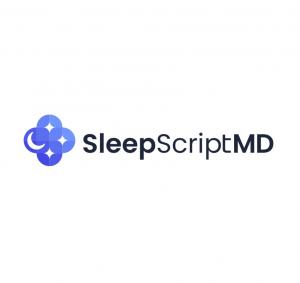
16 Oct 2025
Telehealth provider offers physician-led insomnia treatment and at-home sleep testing, focusing on safety, convenience, and non-addictive medications.
SHELBYVILLE, TN, UNITED STATES, October 16, 2025 /
EINPresswire.com
/ --
SleepScriptMD
, a subsidiary of RefillGenie Inc. and a leading physician-led insomnia clinic, provides comprehensive sleep healthcare through telemedicine for patients seeking safe, non-addictive treatment options. The HIPAA-compliant platform addresses the growing need for accessible sleep solutions in a healthcare landscape where millions of individuals struggle with sleep disorders.
According to the Centers for Disease Control and Prevention, approximately one in three adults in the United States does not get enough sleep on a regular basis. The platform responds to this widespread health concern by offering board-certified physician oversight, at-home sleep testing for sleep apnea risk assessment, and evidence-based treatment plans that exclude controlled substances.
The service operates in more than 40 states and delivers care through two primary models: an AI-assisted, asynchronous platform for streamlined access and virtual telehealth appointments for patients who require or prefer direct practitioner consultation. In most states, patients can complete their entire intake process without scheduling appointments, and prescriptions are typically issued within hours of clinical review.
"We saw a critical need for effective, affordable solutions to improve sleep health—solutions that are safe, non-addictive, and delivered with expertise," said Dr. David Danish, Spokesperson for SleepScriptMD. "Our platform bridges this gap by combining complementary medical expertise to deliver comprehensive sleep care that meets patients where they are."
The platform maintains a strict formulary policy that excludes benzodiazepines and "Z-drugs" to prevent dependency risks. Instead, the medical team prescribes non-controlled, evidence-based medications such as trazodone, clonidine, and hydroxyzine. Each treatment plan receives review and approval from licensed medical practitioners, ensuring patient safety and appropriate prescribing practices.
For patients concerned about potential sleep apnea, the platform offers physician-reviewed at-home sleep testing delivered directly to their residence. This testing option provides clinical follow-up and can help identify underlying sleep disorders that may require specialized treatment beyond insomnia care.
"Super simple process. I didn't have to waste time scheduling a call or explaining my sleep struggles for the hundredth time. Sleeping again, finally," said David L., a patient who completed the asynchronous care pathway.
The platform provides two distinct care pathways based on patient location and clinical needs:
• Asynchronous Care: Available in most states, this model allows patients to complete a secure online intake at their convenience. Licensed providers review submissions and issue prescriptions without requiring scheduled appointments. The first month costs $25, with subsequent months are billed at $42 monthly or $95 for 90-day plans.
• Virtual Appointments: Required in 16 states due to local telehealth regulations or clinical complexity, this option includes 10–20-minute video or phone consultations with licensed providers. Initial visits are priced at $110, with follow-up consultations available at $85 for 5–15-minute sessions.
Brittany, a patient who used the asynchronous model, shared: "I was dreading having to explain my sleep problems again, but thankfully, I didn't have to. Just filled out the form, and they reviewed it, and boom—prescription sent. Honestly, this should be how all medical stuff works. Way easier than going into an office for something like this."
Patients receive access to multiple components within the service:
• Board-certified physician oversight for all treatment plans
• Same-day prescription processing in most states (subject to local telehealth laws)
• Natural supplement recommendations for those preferring non-prescription options.
• At-home sleep apnea testing kits with physician review
• Flexible refill and medication adjustment options
• No insurance requirements or hidden subscription fees
"Honestly, I just needed something that worked, and this delivered. I've been through so many over-the-counter options that didn't do anything, so this was a relief. It took a few days to get set up, but now I sleep like a rock," said Tina, describing her experience with the platform.
The platform was co-founded by Dr. Peter Kelly, a family medicine specialist, and Dr. David Danish, who holds dual board certifications in child/adolescent and adult psychiatry. The founders met during post-baccalaureate studies at a premedical program affiliated with Harvard and established the service to address gaps in accessible sleep healthcare.
Their combined medical backgrounds enable the platform to address both the physical and mental health dimensions of sleep disorders. This comprehensive approach supports patients who may have underlying conditions affecting their sleep quality or who require coordination between different aspects of their healthcare.
The service operates with full commitment to patient autonomy, allowing individuals to cancel or pause treatment at any time without contractual obligations. Prescription medications are paid separately at patients' preferred pharmacies, with the platform serving as the clinical care provider rather than a pharmaceutical distributor.
For more information about the sleep health services or to begin an assessment, please visit
https://sleepscriptmd.com
or call +1 800-737-8385. Additional resources and insights are available on the company's blog at
https://sleepscriptmd.com/expert-mental-health-insights
.
###
About SleepScriptMD
SleepScriptMD, a subsidiary of RefillGenie Inc., and headquartered in Shelbyville, Tennessee, provides accessible, high-quality sleep healthcare through telemedicine. Co-founded by Dr. Peter Kelly (family medicine) and Dr. David Danish (dual board certified in child/adolescent and adult psychiatry), the platform combines complementary medical expertise to deliver comprehensive sleep care. The service offers both AI-assisted asynchronous care and virtual telehealth options, enabling patients to access personalized sleep solutions with safety and efficiency while maintaining the highest standards of medical oversight.
Contact Details:
118 East Side Square Ste. A
Shelbyville, TN 37160
United States
Notes to Editors:
• All clinical care is delivered by licensed physicians or nurse practitioners in accordance with state telehealth laws.
• The medications discussed (Trazodone, Clonidine, Hydroxyzine) are non-controlled and selected through an evidence-based, physician-guided system.
• For asynchronous eligibility, state-specific regulations apply.
End of Press Release.
Dr. David Danish
SleepScriptMD
+1 800-737-8385
email us here
Legal Disclaimer:
EIN Presswire provides this news content "as is" without warranty of any kind. We do not accept any responsibility or liability
for the accuracy, content, images, videos, licenses, completeness, legality, or reliability of the information contained in this
article. If you have any complaints or copyright issues related to this article, kindly contact the author above.
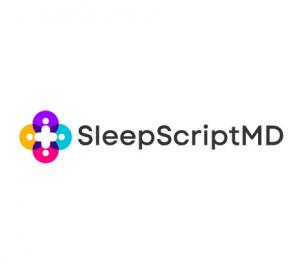
15 Sep 2025
A leading telehealth option for better sleep, combining medical expertise with affordable care and non-addictive treatments, starting at only $25.
SHELBYVILLE, TN, UNITED STATES, September 15, 2025 /
EINPresswire.com
/ --
SleepScriptMD
, a leading professional telehealth platform and subsidiary of RefillGenie Inc., offers comprehensive insomnia treatment through its affordable $25 entry plan, providing patients nationwide with access to physician-supervised sleep care without traditional clinic visits.
The platform addresses the growing need for accessible sleep healthcare by combining medical expertise with modern telehealth technology. With sleep disorders affecting millions of Americans, SleepScriptMD provides an alternative to conventional sleep clinics through its dual-care system that accommodates different patient preferences and state regulations.
Comprehensive Sleep Care Through Telemedicine
• Physician oversight: Board-certified doctors review every treatment plan, ensuring safe, evidence-based care.
• Non-addictive medications: The platform exclusively prescribes non-habit-forming sleep medications, avoiding controlled substances.
• Flexible care options: Asynchronous care is available in most states, with virtual appointments required by local telehealth laws.
• Same-day prescriptions: Treatment plans are typically processed within hours of intake completion.
• Transparent pricing: $25 first month, $42 monthly thereafter, with 90-day options available.
The service operates in over 40 states, with asynchronous care available in most locations. States requiring virtual appointments include Connecticut, Georgia, Indiana, Kansas, Kentucky, Louisiana, Maryland, Mississippi, North Carolina, Ohio, Tennessee, Texas, and West Virginia.
"We saw a critical need for effective, affordable solutions to improve sleep health—solutions that are safe, non-addictive, and delivered with expertise," said Dr. David Danish, spokesperson for SleepScriptMD. "Our platform bridges the gap between traditional sleep medicine and modern convenience."
SleepScriptMD's three-tiered medication system focuses on non-controlled prescription options, including Trazodone for improving slow wave sleep, Clonidine for calming the nervous system, and Vistaril (hydroxyzine) for its calming antihistamine properties. The platform excludes benzodiazepines and Z-drugs from its formulary to prevent dependency risks.
Patient Matthew shared his experience: "The process was simple, and I liked that they actually explained my options instead of just pushing whatever. It took a couple of tweaks to get the right prescription, but now I'm finally sleeping through the night. Totally worth it."
The platform's design addresses common barriers to sleep healthcare, including appointment scheduling difficulties, geographic limitations, and cost concerns. Patients complete secure online intakes at their convenience, with no insurance requirements for service access.
Priya, another patient, noted: "I've been dealing with bad sleep for years, and nothing really helped. This was the first time I actually felt like I was being listened to. The process was quick, and the meds they prescribed have made a huge difference."
Co-founded by Dr. Peter Kelly, a family medicine specialist, and Dr. David Danish, dual board certified in child/adolescent and adult psychiatry, SleepScriptMD combines complementary medical backgrounds to ensure comprehensive patient care. Their collaboration began during post-baccalaureate studies at a prestigious premedical program affiliated with Harvard.
The platform offers both AI-assisted asynchronous care and virtual telehealth options, enabling patients to choose their preferred care method based on individual needs and state requirements.
Patient Jamal E. described his virtual session experience: "My sleep was trash, and nothing was helping. I did the virtual session so I could actually talk to a doctor, and they knew their stuff. They explained why some meds are better than others for my situation, which made a lot of sense. It's been a huge difference for me. 10/10 recommend."
Beyond prescription medications, SleepScriptMD provides natural supplement recommendations and at-home sleep testing options for patients who may have underlying sleep apnea. The platform maintains commitment-free service with no hidden fees and cancellation flexibility.
The service includes ongoing support for dose adjustments and medication changes, ensuring patients receive personalized care throughout their treatment journey.
For more information about SleepScriptMD's sleep care services, visit
https://sleepscriptmd.com
or call +1 800-737-8385. Additional mental health insights are available at
https://sleepscriptmd.com/expert-mental-health-insights/
.
###
About SleepScriptMD
SleepScriptMD, a subsidiary of RefillGenie Inc., and headquartered in Shelbyville, Tennessee, provides accessible, high-quality sleep healthcare through telemedicine. Co-founded by Dr. Peter Kelly (family medicine) and Dr. David Danish (dual board certified in child/adolescent and adult psychiatry), the platform combines complementary medical expertise to deliver comprehensive sleep care. The service offers both AI-assisted asynchronous care and virtual telehealth options, enabling patients to access personalized sleep solutions with safety and efficiency while maintaining the highest standards of medical oversight.
Contact Details:
118 East Side Square Ste. A
Shelbyville, TN 37160
United States
Notes to Editors:
• All clinical care is delivered by licensed physicians or nurse practitioners in accordance with state telehealth laws.
• The medications discussed (Trazodone, Clonidine, Hydroxyzine) are non-controlled and selected through an evidence-based, physician-guided system.
• For asynchronous eligibility, state-specific regulations apply.
End of Press Release.
Dr. David Danish
SleepScriptMD
+1 800-737-8385
email us here
Legal Disclaimer:
EIN Presswire provides this news content "as is" without warranty of any kind. We do not accept any responsibility or liability
for the accuracy, content, images, videos, licenses, completeness, legality, or reliability of the information contained in this
article. If you have any complaints or copyright issues related to this article, kindly contact the author above.

100 Deals associated with Hydroxyzine Hydrochloride
Login to view more data
External Link
| KEGG | Wiki | ATC | Drug Bank |
|---|---|---|---|
| D00672 | Hydroxyzine Hydrochloride |
R&D Status
10 top approved records. to view more data
Login
| Indication | Country/Location | Organization | Date |
|---|---|---|---|
| Depressive Disorder | Japan | 30 Sep 1965 | |
| Eczema | Japan | 30 Sep 1965 | |
| Nausea and vomiting | Japan | 30 Sep 1965 | |
| Anxiety Disorders | United States | 12 Apr 1956 | |
| Pruritus | United States | 12 Apr 1956 | |
| Urticaria | United States | 12 Apr 1956 |
Login to view more data
Clinical Result
Clinical Result
Indication
Phase
Evaluation
View All Results
| Study | Phase | Population | Analyzed Enrollment | Group | Results | Evaluation | Publication Date |
|---|
Phase 3 | 60 | (Regimen 1) | ldgefxjvuv(yurakcbpzg) = nanotnxuuc mimjdjyemf (dtnastwwsl, rprubjjgdk - gynxoelhye) View more | - | 02 Oct 2024 | ||
(Regimen 2) | ldgefxjvuv(yurakcbpzg) = gmaaswouqn mimjdjyemf (dtnastwwsl, mxzzupjsce - abhmtucevq) View more | ||||||
Phase 4 | 37 | (Midazolam, Hydroxyzine, Meperidine) | lokzltazln = lqypwuiwyn yenwfkmenj (evlnmwmbqo, cxmkhwpwnm - ffbfiirvis) View more | - | 05 Dec 2023 | ||
(Midazolam, Hydroxyzine) | lokzltazln = ajsvzpicyc yenwfkmenj (evlnmwmbqo, wsltomflpo - ymrhifcynr) View more | ||||||
Phase 4 | 26 | jlofctlbvw(kbjbdgnorp) = lnveaodurg vafthggppa (fhxsjmxdxg, 2.37) View more | - | 03 Mar 2023 | |||
Not Applicable | 10 | placebo+naloxone (Placebo) | birmsfagxu(ydnnsupbii) = mcuqceocxy csizrovgfd (qngjqvkuvw, 0.76) View more | - | 05 Jun 2017 | ||
(Palonosetron) | birmsfagxu(ydnnsupbii) = qaflxokggi csizrovgfd (qngjqvkuvw, 0.37) View more |
Login to view more data
Translational Medicine
Boost your research with our translational medicine data.
login
or

Deal
Boost your decision using our deal data.
login
or

Core Patent
Boost your research with our Core Patent data.
login
or
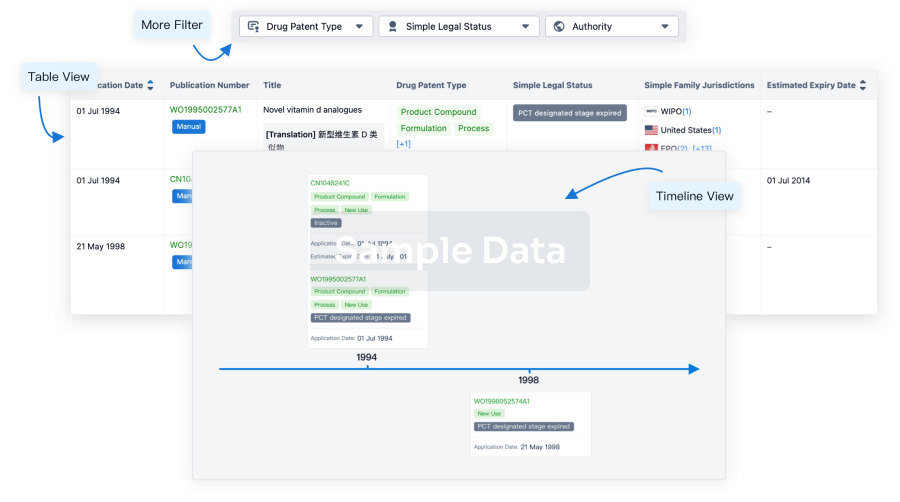
Clinical Trial
Identify the latest clinical trials across global registries.
login
or

Approval
Accelerate your research with the latest regulatory approval information.
login
or
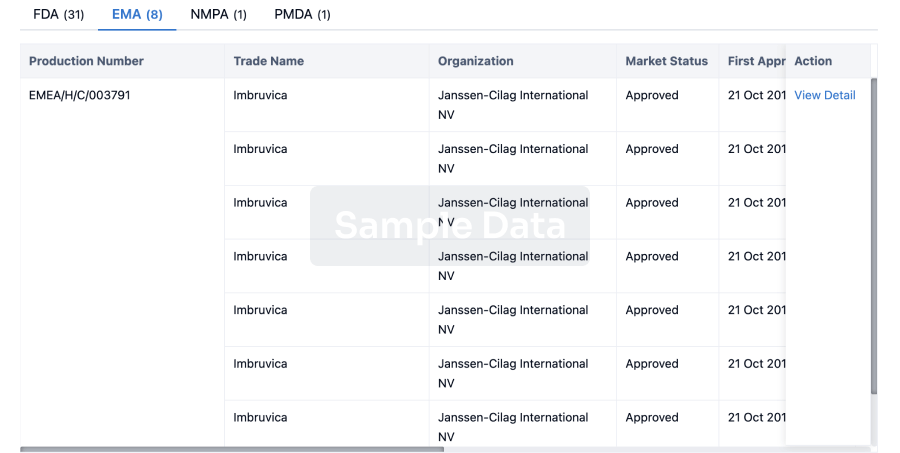
Regulation
Understand key drug designations in just a few clicks with Synapse.
login
or
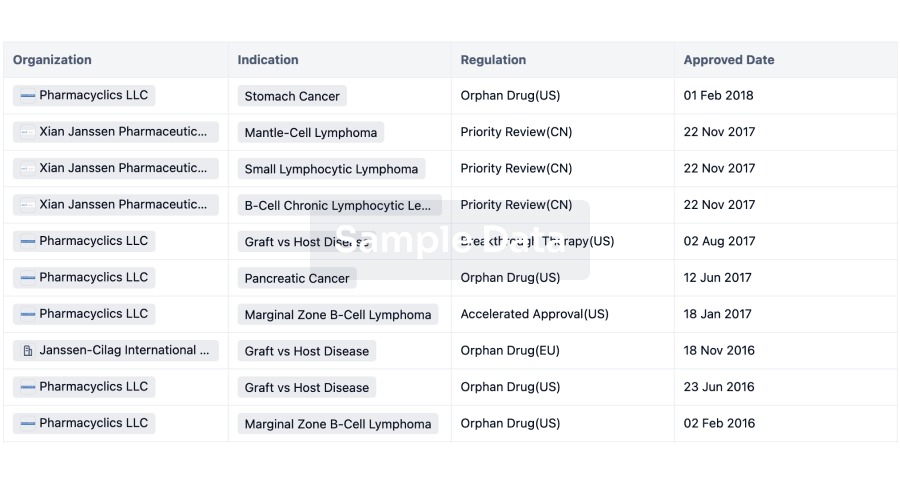
AI Agents Built for Biopharma Breakthroughs
Accelerate discovery. Empower decisions. Transform outcomes.
Get started for free today!
Accelerate Strategic R&D decision making with Synapse, PatSnap’s AI-powered Connected Innovation Intelligence Platform Built for Life Sciences Professionals.
Start your data trial now!
Synapse data is also accessible to external entities via APIs or data packages. Empower better decisions with the latest in pharmaceutical intelligence.
Bio
Bio Sequences Search & Analysis
Sign up for free
Chemical
Chemical Structures Search & Analysis
Sign up for free




